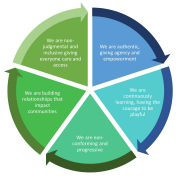This summer I finally made the leap to get our Capillary Values created formally. To no longer be an informal, undercurrent of beliefs and principles, we all kind of knew, but to actually be something tangible and real. This was a follow up to my previous declaration in an earlier blog post that we needed to get my act together and stop helping other create strategy etc. when we needed to do so ourselves.

We met for the day in early August and of course I used the Emotional Culture Deck (ECD) to help in our journey. It was a fascinating realization as we focused on words that meant something to us, the way we are and the way we deliver our offerings. We used the ECD to reflect on the comfort levels of various statements, highlight words we didn’t want, words we really had to have and other pieces of the essence we had to have driven within the core of what we were developing.

This was not an easy journey to undertake. I personally had to let go of a lot more than I maybe let on during the day. Capillary is my child, my baby, my creation and I am strongly bonded to it. However, like any parent, I want it to create its own persona and become its own self determined entity. So I bit tongue and lip and let the conversation flow.

As the conversation flowed and content began to solidify, we recognized three considerations about the content we were creating.
- We didn’t want to create a list. That would indicate different values and confirm a hierarchy of position amongst the values.
- Our values would also be our principles. We couldn’t separate them and recognized that it was all together in one train of thought.
- We would be reflecting the experience of our audiences and how we would be present for them – its not about us, but about them.
So what did we end up with, I hear you ask. We created a Values wheel as shown below with five statements of behaviour.

The important thing to reflect is that it is a wheel, that is continually turning. All of these are equally important, and we cycle through them all regularly. Sometimes one or two may come to the fore, other times all of them but it is not for us to apply any one as more relevant or more important than another. The audience, client, customer, participant or whoever we connect with, will pull and embrace those elements from us they need at that time.



